
As told exclusively to
Mike Hutcherson started out working for Lotus Cars in the early 60s testing brand new Lotus Elans, lapping the Mira test track at 135mph.
Mike then got a job at Jack Oldings in 1965 where he met Nobby Hills and saw the unfinished Cadillac powered dragster Houndog 3 with front mounted blower. Nobby was looking for a new driver and after hearing about Mike’s experiences at Lotus asked him if he’d like to drive it? Mike wasted no time saying yes.
They ran the dragster at Santa Pod when it opened in 1966, constantly developing it getting quicker times and faster speeds. Mike enjoyed the engine development side of it and helped with making parts for the car, machining blower pulleys, splining driveshafts etc.
Mike also recalls memories of other racers at the time including Alan Blount, Ken Cooper and Walt Ithell...
Mike's story was produced by John Hunt and Nick Pettitt, and published by Eurodragster.com editor Simon Groves.
I was born on 20th October 1941 a war baby, in Digswell, Hertfordshire. Funnily enough I didn’t see my father until the best part of 1947. When he got demobbed, he had to go to Palestine where there was trouble at that time. I went to a secondary modern school called Howards, a brand-new school which had everything except a canteen and swimming pool.
I left there when I was 15 and I got a Mechanical Engineering Apprenticeship with ICI as a fitter, turner when I was 16 and worked there until I was 21 or 22. We also did some construction and maintenance work. Then I went and worked for a firm that made big diggers. Wetherill Hydraulics, I was there for about a year.
A friend of mine worked at Lotus in Cheshunt and he said they needed another bloke in the development department, so I went along and had an interview and got the job. That was absolutely fabulous, I was 22. Suddenly we had a brand-new Lotus Elan available, it was a development car we used to do all sorts of modifications to it. I used to go up to Coventry to Mira test track, which is a triangular track with banked parabolic corners. It was unbelievable, I could lap around there at about 135 mph in a Lotus Elan going round the corners. It was a left-hand drive car and after about 2 laps I thought I can do this, because everybody thinks they’re a great driver don’t they, until the chips are down, then you find out for sure. I loved it and it went on for a while.
One day I tested for 24 hours with two professional drivers they’d hired. We had a Lotus Cortina and Lotus Elan with an experimental engine in. We used to alternate; I drove both cars an hour each at a time. Then the Cortina broke down and the second professional driver smashed the Elan up, he swerved to miss a pheasant on the banking and wrecked it. So, we only did about 12 hours after all.
That was the engine that caused my downfall because we took the experimental engine out and we put it in another car and it all went wrong. We did modifications and made the odd bits and pieces but didn't have a machine shop as such, the parts would be made and came in. One day I stood at the end of the production line and collected a brand-new Lotus Cortina straight off the line, signed for it and drove straight up to Coventry with it. I used to work with an engineer. He lived in Coventry where Mira was, wonderful days, just wonderful days.
We did one day have to make a new distance plate for the back of the engine to fit a ZF 5 speed gearbox. I’m not sure how true it was but apparently the gearbox cost more than the complete car. I borrowed the car one weekend. This would have been in the mid 1960s.
The Lotus twin cam engine was basically a copy of the Alfa Romeo twin cam cylinder head and the bottom half was Ford GT. The very first original Lotus Cortinas were aluminium bodied but they were so delicate that when you shut a door they would fold in and they weren't practical. They still made the Lotus 7, Elan and Cortina while I was still there. They were building a car for their first Indy 500 with Jim Clarke as their main driver. My mate Andy was asked to go over to the racing workshop and work a night shift putting the car together and he did the exhaust system. We couldn’t get it on the TV in the 1960s only on the radio so you could only hear it and Jim Clake won it that year and the following year Graham Hill won. I never went away with any of the teams.
We’d fitted an experimental engine into a Ford Corsair for a Ford director which had a fancy paint job. When he came and collected it, he was going down the High Street and the throttle stuck open and they weren't pleased at all. The apprentice that worked with me had left a little piece on the carburettors. Although it wasn’t sticking all the time, sometimes it did, it was like the vibration pulled it back and the throttle stuck open and they weren't very happy with me, so we left, escorted off the premises. Thankfully there was no damage and no one was hurt. This was at the end of 1965.
Colin Chapman was quite ruthless when it really came down to it. There was an instance at Lotus where they changed from aluminium bodied race cars to fiberglass and he had a team of specialists making aluminium bodies and said sorry boys you’ve got to go, just like that, that’s how he was. They often say you have to be ruthless to be successful, and he was. But of course, he was a genius. An amusing thing about him was when they won the Indy 500 he was given a Ford 500 Galaxy, an American car and that’s what he used for his personal transport when I was there.
I went with my work mate Andy to the first meeting of the International Drag Festival in September 1964 at Blackbushe, which was spectacular. It was just amazing. Nobby had a car there, it was his first Houndog dragster powered by a blown Jag. He and Allan Herriage with his straight eight Buick dragster were two of the pioneers if you like.

Nobby Hills and crew at the '64 Blackbushe Dragfest with Houndog 1. Brian Sparrow pic. |

Houndog 1 gets the crossplies smokin'. Brian Sparrow pic. |

It ran a best of 14.46/83m.p.h. Stephen Wright pic. |
Anyway, after I left Lotus, I went to Jack Oldings Ltd where Nobby was. Once I’d met Nobby I remembered seeing him and his dragster at Blackbushe. They took me to a shed and showed me this half-built Dragster which would become Houndog 3. It then occurred to me he built long Dragsters like the Americans as he had a big workshop where he worked. Most other people only had small garages. I think that’s why for the first few years there were many more short wheelbase cars built.

Jack Oldings. |

Nobby built Houndog 3 at Jack Oldings in 1965 and '66. |
Apparently Nobby was having a problem with the bloke who was driving his car at the time. Once they found out I’d worked for Lotus, I think they thought I was a hot shot. Nobby came to me and asked if I’d like to drive it for him and I said yes, I’ll do that.
Nobby’s first two dragsters had blown Jag engines. This new one had a 1953 Cadillac engine and an advantage was they were quite a lightweight engine but the disadvantage was they had siamese centre exhaust ports so you only had three exhausts each side instead of four. I didn’t have a lot to do with the building of the car.
We went to Santa Pod for the very first time in 1966. It was really weird; it was just the opening, a great big space with concrete, there were cars everywhere, all sorts of cars and only a few real dragsters including Allan Herridge who was also now running a Cadillac motor in his dragster Pulsation.

July 1966, first time out. Mike drove with white overalls then later changed to a silver fire suit. |

A rainy day at the Pod. |

Nobby hard at work in his turn-ups. Ron Fisher pic. |

Tail end treatment on Houndog 3 was a copy of Tony Nancy's 22 Junior. |

While the front was fashioned after Joe Shubeck's Schneider Cam Special. Ken Robbins pic. |
Bob Phelps came along, and nobody knew what to do. Everyone was just standing around and there was no start procedure. So, Bob got a flag and stood in the middle of us, pointing at us with the flag one at a time and then down with the flag and off we went. Anybody raced anybody it didn’t matter what it was and of course as you know where the end of the strip is now, was where the old strip used to start and where the control tower, that had been left behind on the airfield, was.
My brother Peter was twelve and he used to come racing with us, we used to camp and all go down the pub. I think it’s where he had his first drink. We used to chalk all over the beams in this pub, the Houndog team was here and all that sort of thing.
Nobby came up with the name Movin’ Mike, he said you all have to have names and thought of Movin’ Mike then wrote it on the car.
Nobby had fitted a front mounted supercharger which was huge and he just couldn’t get it to work. He tried pulleys then a double duplex chain, but that didn’t work. With my engineering experience I knew there was a machine at ICI which had what we called a cush drive, which was two aluminium discs butted together with big bolts. So we fitted it with this cush drive and it worked well. Then it was a matter of tuning the engine. Nobby built his own injection, we made the butterflies and all sorts of things then it started to run. It progressed and progressed and was so interesting. Nobby wanted to get as much power out of this Cadillac engine as he could. It was a very healthy car and would run about 120 mph consistently.

Large front mounted Rolls Royce Wade blower. Brian Sparrow pic. |

Home-made fuel injection featured a single four inch bore choke. Brian Sparrow pic. |

Mike’s office. Brian Sparrow pic. |

The Houndog Team get ready for a run followed by Ken Cooper and Brian Witty. Brian Sparrow pic. |
When the supercharger was not running, we took it off and ran it on four SUs on ram stacks as a temporary measure. They were sticking in the air like deer horns.
Nobby would come to me and ask could you make me this and make me that. He knew exactly what he was doing. That’s how it all started. Then he said I’ve got two axles and driveshafts that needed splining on the ends. What a job that was. I’d left Jack Oldings where I’d met Nobby after about three or four months and I was now working at Polypenco, a plastics factory in Welwyn Garden City. I had my own little section with a brand-new milling machine, lathe, furnace and all the equipment to make anything. They didn’t know about the things I made for drag racing. I splined these shafts which took a while as American steel was good stuff and quite hard.
At this time an opportunity came up to do an advert for Cadbury's chocolate. We spent two days filming for this but it never saw the light of day unfortunately. But what an experience it was to do. From that we did an advert for the Rover 2000 TC which was in all the papers.

Sunday Express 02-10-66 |

Sunday Express 02-10-66 |
There was an incident once when we raced Ken Cooper in the pouring rain. Nobby did say to me which I won't repeat, but it was, you’re ******* mad.

Taking on Ken Cooper in the rain in 1967. |
There was a funny thing about a bloke who used to race at the same time called Alan Blount whose car was called Weekend Warrior. It was early days and we just got our car going pretty well. Alan’s car always used to smoke something shocking. Well one time I was racing him and I remember that we were on the start line and Nobby said Alan’s still burning oil or maybe it was coal or something, as we both laughed.
Anyway, we raced, and I never saw him, I was in the left-hand lane. Now in order to turn round and come back you had to go over into the other lane due to a very limited turning circle. So, I started to slow right down and started to cross into the other lane to get the turning circle and he came flying past my right ear. I didn’t know what he was up to and he went straight into what turned out to be a huge pile of dung. I watched them pulling the car out by rope and as they pulled it backwards it was filling up with dung. As you can imagine everybody was in hysterics.
That sort of thing happened, and everybody was really friendly. There were a lot of blokes who built their own dragsters in their garages and turned up with them.
There was a bloke called Walt Ithel and he was absolutely useless, he turned up with the biggest load of old rubbish you’ve ever seen and it would be dribbling oil everywhere and never ran properly. He had Holley carburettors on it and where you could take the top off instead of a proper seal, he’d used squares of sponged rubber that you used in the bath. He turned up one day with a twin engined car and all sorts of weird things.
Harold Bull and John Whitmore built miniature dragsters. They were absolutely beautiful things and they went like stink, as well, 1000 cc BMC engine, supercharged, they were great, really good.
Modified production cars and competition altereds started to become more popular as I think dragsters were getting too long for the average garage.

Movin' Mike. |

Horizontal stripes were the in-thing in '68. Ken Robbins pic. |

Fuel tank was made from part of a fire extinguisher. |

The nose had now been sealed up. Ken Robbins pic. |
There used to be RAC scrutineers you know, which was the biggest laugh and joke. I always used to take a golf club with me because the scrutineer I think his name was Tom, we used to have a right little banter with him and he was a golfer. Captain Tom Hales, that’s him he was great. He used to get his pencil and go round the spokes, cha ching, cha ching and that was it, that was all he ever did and it was all because we were under the RAC.
Perhaps this isn’t generally known, I applied and got a license and every year you sent it away and got it stamped and it took them about three or four years for the penny to drop at the RAC because I was in possession of a full FIA racing license which you acquired after the third year. I could have driven a Formula 1 car and they suddenly twigged. So they said they were introducing a new license for sprints and drag racing, called a speed license. I’ve still got the original one. It's upstairs somewhere but in a couple of pieces.
For the first two years we were actually unbeaten. Then two young fellows from Cornwall decided to build a car called Tudor Rose powered by a Keith Black 426 Chrysler hemi and we couldn’t compete, although we tried our best. We went through five or six Cadillac engines in one season. We used to buy them from the scrap yard. I can remember the time when Nobby said he hadn't any money left, going on to say there's an engine in the scrap yard for £29. So, I wrote him a cheque for £29 (I only had £34 in the bank) and we carried on.
Gallery: click on any thumbnail for a large image.
 |
 |
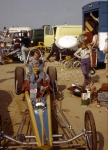 |
 |
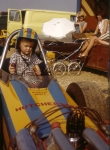 |
 |
 |
 |
 |
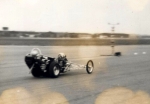 |
 |
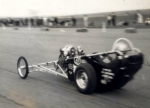 |
 |
 |
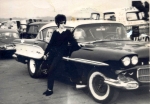 |
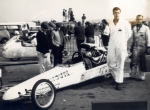 |
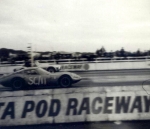 |
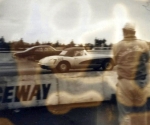 |
 |
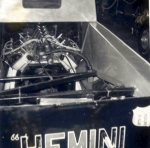 |
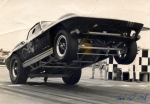 |
 |
 |
 |
 |
Back to pioneers index
Back to News page













